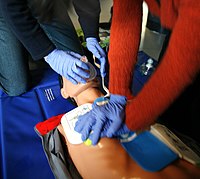
Photo from wikipedia
Supplemental Digital Content is available in the text. OBJECTIVE: The goal of this work is to provide insight into survival and neurologic outcomes of pediatric patients supported with extracorporeal cardiopulmonary… Click to show full abstract
Supplemental Digital Content is available in the text. OBJECTIVE: The goal of this work is to provide insight into survival and neurologic outcomes of pediatric patients supported with extracorporeal cardiopulmonary resuscitation. DATA SOURCES: A systematic search of Embase, PubMed, Cochrane, Scopus, Google Scholar, and Web of Science was performed from January 1990 to May 2020. STUDY SELECTION: A comprehensive list of nonregistry studies with pediatric patients managed with extracorporeal cardiopulmonary resuscitation was included. DATA EXTRACTION: Study characteristics and outcome estimates were extracted from each article. DATA SYNTHESIS: Estimates were pooled using random-effects meta-analysis. Differences were estimated using subgroup meta-analysis and meta-regression. The Meta-analyses Of Observational Studies in Epidemiology guideline was followed and the certainty of evidence was assessed using Grading of Recommendations Assessment, Development and Evaluation system. Twenty-eight studies (1,348 patients) were included. There was a steady increase in extracorporeal cardiopulmonary resuscitation occurrence rate from the 1990s until 2020. There were 32, 338, and 1,094 patients’ articles published between 1990 and 2000, 2001 and 2010, and 2010 and 2020, respectively. More than 70% were cannulated for a primary cardiac arrest. Pediatric extracorporeal cardiopulmonary resuscitation patients had a 46% (CI 95% = 43–48%; p < 0.01) overall survival rate. The rate of survival with favorable neurologic outcome was 30% (CI 95% = 27–33%; p < 0.01). CONCLUSIONS: The use of extracorporeal cardiopulmonary resuscitation is rapidly expanding, particularly for children with underlying cardiac disease. An overall survival of 46% and favorable neurologic outcomes add credence to this emerging therapy.
Journal Title: Critical Care Medicine
Year Published: 2021
Link to full text (if available)
Share on Social Media: Sign Up to like & get
recommendations!